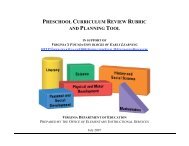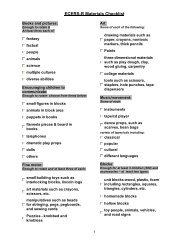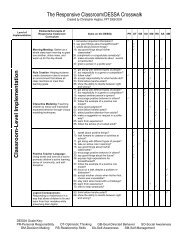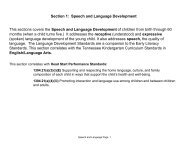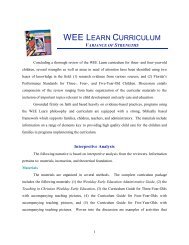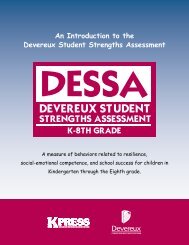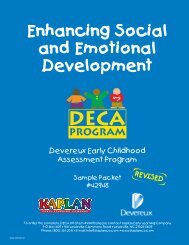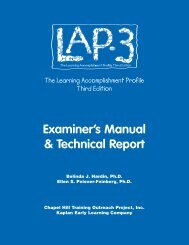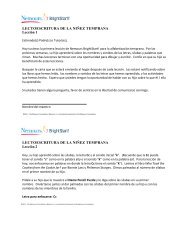Examiner's Manual & Technical Report - Kaplanco.com
Examiner's Manual & Technical Report - Kaplanco.com
Examiner's Manual & Technical Report - Kaplanco.com
- No tags were found...
You also want an ePaper? Increase the reach of your titles
YUMPU automatically turns print PDFs into web optimized ePapers that Google loves.
• To assist in the identification of children with disabilities and the subsequentdevelopment of an IEP when used as a part of a multi-disciplinary evaluation. Theappropriate evaluation of young children should utilize both informal (e.g., observation,work samples) and formal techniques such as the LAP-D (NAEYC & NAECS/SDE,2003).• To conduct research on the development of preschool, kindergarten, or special needschildren.• To train teachers, paraprofessionals, clinicians, and parents on developmentallyappropriate assessment practices.• To assist early childhood programs in meeting national and state requirements (e.g., HeadStart Child Out<strong>com</strong>es, state standards)Limitations of the LAP-DThough the LAP-D has many possible applications, the examiner should apply some basicprinciples in its use. The LAP-D should never be used as a single measure for makingeducational decisions; rather, it should always be used in conjunction with a variety of formaland informal assessment procedures administered by different individuals.Children functioning at the lower end of the age range (below 36 months) may be more fullyevaluated using the Early LAP, which is designed to assess children birth to three years of age.For these children, the Early LAP assesses a wider range of behaviors below the 36-month agelevel.User QualificationsThe LAP-D is a norm-referenced instrument with clear guidelines for administration. Careshould be taken to follow these specified guidelines in order to achieve the most accurate results.Administration of the LAP-D does not require specific licensure or certification; however,training and/or experience in assessment procedures is essential for effective administration.Trained teachers, paraprofessionals, clinicians, special educators, psychologists, occupationaland physical therapists, speech-language pathologists, and others familiar with childdevelopment can administer the LAP-D. To ensure appropriate and accurate use of assessmentinformation from the LAP-D, the examiner must be<strong>com</strong>e thoroughly familiar with theExaminer’s <strong>Manual</strong> & <strong>Technical</strong> <strong>Report</strong> through self-study or professional training. TheStandards for Educational and Psychological Testing (1999) re<strong>com</strong>mends that test users “studyand evaluate the materials provided by the test developer (p. 113).” The Standards especiallyemphasize knowing the purposes, administration procedures, and appropriateness of theassessment for specific populations, as well as the reliability and validity of the assessment. Inaddition, examiners should practice administration of the assessment to help develop or improvethe skills necessary for effective administration.5




